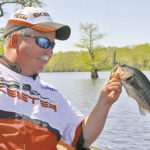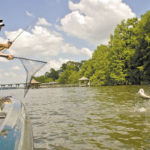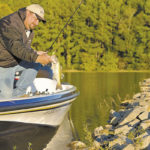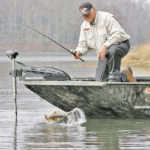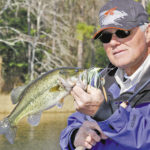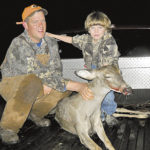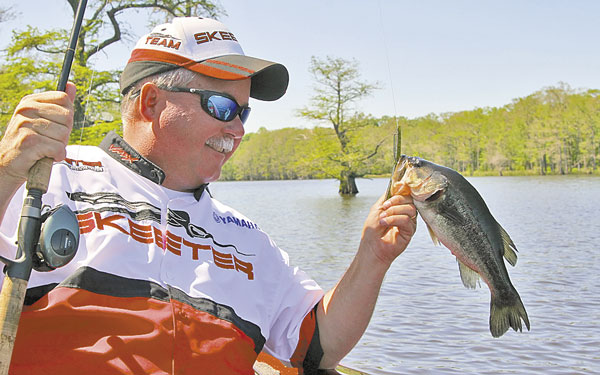
Thinking of throwing that small bass back? If so, you’re actually doing more harm to the resource than good.
Old habits die hard. Don’t believe me? Go ask Bass Anglers Sportsman Society founder Ray Scott, who spearheaded the catch-and-release phenomenon in the 1970s how much trouble he had convincing a bunch of backwoods bubbas to release bass back into Lake Guntersville rather than “Lake Crisco.”
Scott finally had success — perhaps too much of it.
While a noble and sometimes lake-saving movement, the trouble with catch-and-release was that it became more of a cult religion whose members verbally and mentally abused those who didn’t give their bass a little kiss and pat on the head before acting as savior and sliding them back into the water.
I know because I was as brainwashed as anybody in the movement. My boat’s livewell was to keep fish alive for tournament weigh-ins rather than to transport them to the fish-cleaning table. Anybody in my boat who did otherwise became the object of sharp, down-my-nose glances and passive-aggressive ridicule.
Before the end of the 1990s, keeping bass for supper might as well have been added to pride, envy, gluttony, lust, anger, greed and sloth, the seven — no, make that eight — deadly sins.
But the very anglers who eventually learned to catch and release their fish are now some of the primary reasons why slot limits at Poverty Point, Caney Creek Lake, Spanish Lake, Caddo Lake, Black Bayou Lake, Chicot Lake, Cross Lake, Lake Rodemacher, Grand Bayou and Vernon Lake haven’t had nearly the impact that they could have.
Each of these lakes has a regulation requiring anglers to immediately release bass that fall between certain length measurements. These “slot lakes” also limit the number of bass over the upper end of the slot that anglers can keep. The only restriction on bass falling below the slot limit is Louisiana’s typical 10-fish largemouth bass creel limit.
Slot limits were put into place on these lakes to improve the overall quality of bass fishing and to create a healthier bass population with more trophy-sized fish than other Louisiana waters.
“Slots were designed to shave off smaller fish to make more forage available for larger ones,” said LDWF Senior Fisheries Management Advisor Mike Wood. “Without meaning any harm, and often with the very best intentions, many anglers throw back all bass rather than only those in the slot.”
When this is the case, slot limits become nothing more than numbers on a sign at the boat launch telling anglers what they should do. The problem comes in getting anglers to participate beyond releasing bass within the slot limit because we are so conditioned to practicing catch-and-release.
“Throwing back the small ones compromises the slot limit to some extent because we are putting back the very same bass that we’re trying to remove to reduce competition for food,” Wood said. “Releasing small bass under the slot limit keeps this regulation from working as it should.”
This was precisely the same mentality that led deer hunters to not shoot does even though organizations like the Quality Deer Management Association implored hunters that, on many lands, shooting more does would lead to a healthier overall deer herd with bigger bucks sporting bigger racks.
Look how long it took for people to understand the concept of shooting does to improve deer herds. However, even today, you wouldn’t have to visit too many barbershops to find a well-meaning hunter sitting in the chair saying to anybody who’ll listen, “You know what you need to do? You need to let that herd grow for three years without shooting does. Then you’ll really have something.”
“Not only do old ideas die really hard,” Wood said, “they also die very slowly. In some cases, it takes a lot of slow walking and getting a new crop of hunters or anglers who are more open to suggestion — who will listen a little bit. Management, whether for deer or bass, is a learning process for everybody.”
Take Wood’s own LDWF, for instance. This department was selling the idea back in the ‘20s, ‘30s, ‘40s and ‘50s that it was important to not shoot does because there weren’t many deer. But the situation changed as the increasing population became a success story.
On the other hand, hunters didn’t change with the situation, and many held firmly to the idea that if it was good medicine to not shoot does then, it must be good medicine to not shoot does now. For them, shooting does remained a deadly sin. The often-overlooked fact, though, is that there were maybe 500,000 deer in the nation back then while that number is estimated at over 30 million today.
This sounds very familiar to bass anglers who believe releasing everything they catch continues to be the right thing to do just because that’s what their first issue of BASSMASTER magazine told them to do.
It might take a while to sink in, but the reason we should keep the smaller bass at these slot lakes is the same reason why we should shoot does on our properties.
Releasing small bass and letting does walk contributes to overpopulation, and overpopulation means fish and deer exceed the carrying capacity for a particular lake or piece of land.
Every Louisiana hunter who has taken the LDWF Hunter Education course has seen the drawing of the bathtub in the course manual. This tub visually depicts the concept of carrying capacity.
Simply put, the size of the tub represents the carrying capacity of a habitat at any given time. Water going into the tub represents births and water draining out of the tub represents deaths.
When there is too much water going in (births) without the same amount of water coming out (deaths), the tub fills, and water (animals) overflows and sloshes out of the tub (overpopulation).
As the ultimate predator, hunters and anglers don’t have much influence in the number of births, but we do have an influence in the number of deaths. Therefore, we can do our part to keep the water from overflowing out of the tub.
Take deer for example. According to QDMA publications, when deer are above the carrying capacity of a piece of property, the number of fawns born per doe is reduced. This is dictated by available nutrition and stress.
However, when deer populations are kept below carrying capacity by including does in the harvest, available nutrition is increased and more fawns are born per doe.
Louisiana Deer Study Leader Scott Durham explained this principle in layman’s terms.
“Say you have a tract of land that can support 100 deer,” said Durham. “You’ve determined that you’ve got an annual recruitment, births, of 30. That means you’ve got to shoot 30 deer to keep your population under your property’s carrying capacity.
“Removing X number of deer is the bottom line regardless of whether they are bucks or does. But the females are the reproducers, so if you’re really trying to reduce your deer herd you still key on does.”
Reducing a deer herd in this way has lots of other effects besides reducing competition for available browse. Things like sex ratio and increased recruitment work together with staying within the carrying capacity of a property to produce the healthiest deer population possible on that property.
Keeping bass that fall under a slot limit is all about keeping the bass population under a lake’s carrying capacity, thus preventing overpopulation and the stunted fish that result.
Louisiana Bass Facts, a document published by the Louisiana State University Agricultural Center, Louisiana Cooperative Extension Service and the Louisiana Sea Grant College Program states, “If a given reservoir can produce 40 pounds of bass per acre per year, fishery managers must try to decide whether the public would prefer four 10-pound bass or 40 1-pound bass from that acre of water, or some combination.”
This document’s explanation for slot limits is that they are based on the principle that bass populations exhibit different habitat requirements during different phases of their life histories. Slot limits focus on protecting one segment of the life history, which can influence overall fishing success.
Wood says that it all goes back to many of the slot-limit lakes being managed as trophy bass lakes that required management practices in response to the public wanting larger bass.
“The trophy bass lakes with the slot limits were the priority when stocking Florida bass,” said Wood, “because we picked lakes that, at the time, had the potential to make the most out of the genetics of the bass we were stocking.”
Even now, anglers at many of these slot lakes are wondering why they are struggling to catch big bass when so many Florida bass were stocked and slot limits were implemented. Perhaps the answer lies in the fact that state agencies can only conduct studies and implement fishing regulations; the public has to follow them.
“We’ve got some guys clamoring in Shreveport — some of those lakes — they’ve been waiting on big bass, but they’re just not seeing them,” Wood said. “We started managing those lakes with slots, but the big fish just aren’t showing up. I don’t know how many bass under the slot get released, but every one that does takes away the potential to grow big bass.”
If catch-and-release has become too ingrained in the bass fishing public to the point that anglers just can’t make themselves keep small bass, perhaps there are other ways to manage Louisiana’s lakes that take that into consideration.
“We’ve developed to the point that we can predict and evaluate some things,” Wood said, “but we just can’t go grab some water and make it happen. We really have to have angler participation in selective harvest at these slot lakes to make the slots work. But if our efforts aren’t productive, we need to go back to the drawing board to see what we can do.”
Why go back to the drawing board, though, when there are regulations in place that will improve the bass fishing at slot lakes? All it takes is a change of mind, a filet knife, some cornmeal and an empty stomach.
That guilt pang you feel the first couple of times you fry small bass will slowly fade away.
